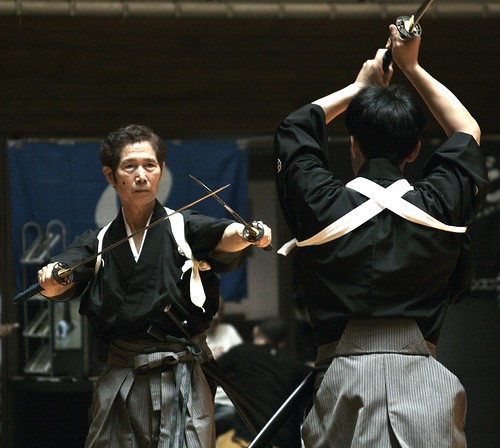For starters, let me pose this question:
Are you studying budo, goshin or konran? Don't know what they mean? Let me define them this way. Budo 武道 is "martial arts", Goshinjutsu 護身術 means to "protect one's body" and Konran 混乱 means "confusion".
If you ask around the Bujinkan, most people will say "budo". But, some will say "goshinjutsu". Nobody will say "konran". If you talk further, away from Japanese terminology, people begin to talk about "self-defense", which is Goshinjutsu. But, as you talk even further, especially with the more experienced students and teachers, most admit that learning Soke's art is to always be in a constant state of "confusion" (Konran).
So, what are you training in?
I am going to make a set of statements that might offend some, make some squirm, maybe even begin to question themselves and what they are doing. But, it has taken me many years to finally accept these as fact and in accepting them I have come to find clarity and purpose - two things I have very seldom been able to find along this martial "path" I've followed for so long. Here are my statements:
1. If you are training in Budo, you are not training in Goshinjutsu.
2. If you are training in Goshinjutsu, you are not training in Budo.
3. If your training is Konran, you are not training in Budo or Goshinjutsu.
Now, before the flames start, let me clarify.
Budo is martial "ART", as in it is a form, a particular expression of something, done in a manner that follows a particular method. All arts have their structure and purpose, whether dancing, painting, sculpting or martial arts. They have a teacher who teaches pupils to learn key lessons that portray the unique attributes of that art and, very often, carry the specific influences of that teacher - and all those teachers before who have handed down those teachings. The purpose is the art itself.
Goshinjutsu is, literally, to protect one's self. It is pure in that there is no specific 'form'. The sole purpose is preservation. So, the methods vary by circumstance and it's entirely comprised of techniques for survival, doing whatever works. It is the world of "henka" or variation.
Konran is confusion, a state of being where there is no direction, no vision, no clarity, no definition, no form or any sense of balance. It goes far beyond just not knowing something.
When you train in Budo, you are learning the art. The techniques are used to teach the art. The principles are there to teach the art. The concepts and strategies are there to teach the art. The headmaster, Soke or Sensei, is there to represent the art to their deshi (students).
When you train in Goshinjutsu, you are applying techniques, strategies and principles in combat situations. You train to escape or defeat an opponent under a variety of circumstances, using whatever resources are available, with no consideration for any particular form, method or "art" (outside of particular conditions presented in the training).
When you train in Konran, you are acting entirely on impulse and base animal instincts. Adrenaline cocktail induced shutdowns and freezes are most likely to happen.
As a budoka, it's important to train in Budo, to learn the form, the art, as completely as possible. But, you also need to practice Goshinjutsu by applying your training to a variety of situations, to adapt it to a broad range of circumstances, challenge yourself with it, take it outside the confines of the form to build practicality and implementation skills with what you learn. This gives it purpose beyond the art itself. Lastly, it's important to step outside the box, to take your training into areas which are uncomfortable and challenging, to create confusion and adrenaline. You need to experience the 'freeze', the fear and shock of something unexpected, new and unpredictable.
To train in these three methods is how a well rounded budoka can be developed. But, let's not fool ourselves into thinking that by training in one, we are training in the others. You do so at the sacrifice of it all. It is all too easy to try to change the art, the budo, when one tries to apply them to mock "self-defense" situations. But, true "self-defense" is a very broad, multi-layered subject that incorporates the reality of violence, the world of predators and social violence, the legal aspects and use of force rules, and the physical, mental and emotional aspects involved. Most of what we see as budo (martial arts) do not cover these areas in quite so specific of a manner. But, training in self-defense also doesn't cover the refinement, the efficiency, the beauty that a budo path offers. There's no history, culture or substance outside of immediate practicality to dealing with real world danger and liabilities associated.
The problem happens when one trains in budo, learning an art, then tries to force it into a real world self-defense situation without going into all the other components that define self-defense. They spend their time changing the art to make it fit, losing the foundations that make the art an art, turning it into something else that most often becomes the budoka's own thing instead of the art they profess to train in. That is fine and can be an effective system if the skills are solid, but it's not the same art. Without a strong reinforcement and constant connection to training in the art, this undoubtedly can lead to confusion, or konran, especially if one continues to try and convince himself that he is still training in that art.
There is more I could write on this, but I'm going to leave it here. My point is simply to suggest that we each look at what it is we are doing in our training and ask:
Are you really, truly training in the art, in self-defense or in confusion?







